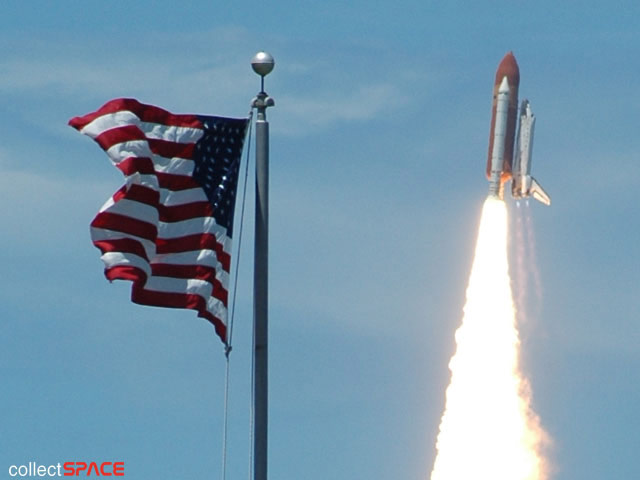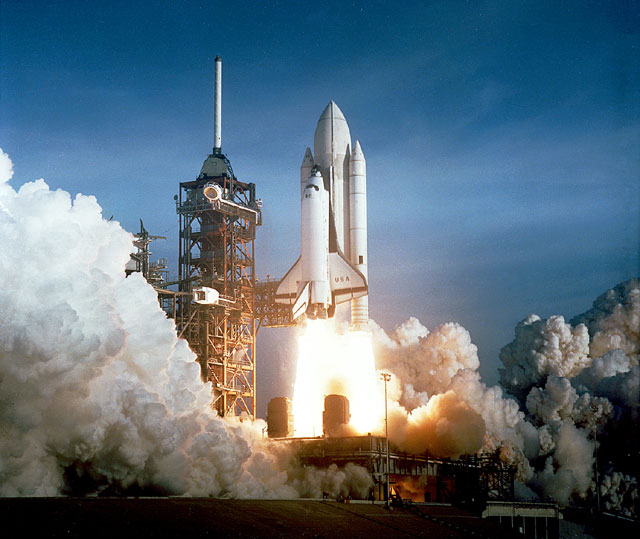5 Patriotic Space Shuttle Missions

NASA's space shuttles have been icons of American spaceflight for over 30 years, but the storied space planes are retiring for good this year after one final mission this month.
The shuttle Atlantis is poised to launch NASA's final shuttle mission , called STS-135, on Friday (July 8) at 11:26 a.m. EDT (1526 GMT) from the agency's Kennedy Space Center spaceport in Florida. Atlantis will fly a 12-day mission to the International Space Station to deliver spare parts and supplies.It will be the 135th and last mission for the shuttle fleet since flights began in 1981.
As NASA prepares to shut down its iconic shuttle program, here's a look at five of the most patriotic shuttle missions ever flown:

1. The home of the brave
The first space shuttle mission, STS-1 (Columbia), launched on April 12, 1981, kicking off three decades of the shuttle program. The mission came twenty years after the (former) Soviet Union won the first leg the space race by putting the first person in space, Yuri Gagarin. STS-1 was 54 hours long, during which the shuttle orbited Earth 37 times. [Photos: NASA's First Shuttle Launch, STS-1]
As the most complex spacecraft ever, it's surprising to note that it was also the first U.S. manned space vehicle launched without an unmanned powered test flight. Because of this, NASA described the mission as "The boldest test flight in history."

2.Free flying
Breaking space news, the latest updates on rocket launches, skywatching events and more!
During the Cold War, the United States kept fighting for new bragging rights in space adventures. A big step for the U.S. came in 1984, when Bruce McCandless II became the first human to make a free, untethered spacewalk (using the Manned Maneuvering Unit) during STS-41B, and thus becoming the first true "human satellite."

3. America's favorite telescope
In 1990, STS-31 set off with the sole mission of deploying the Hubble Space Telescope — the only telescope in orbit that is also designed to be serviced and repaired in space. Hubble is one of NASA's most successful and long-lasting science missions, and many Hubble observations have led to breakthroughs in astrophysics and have provided some of the most stunning photos of deep space, among those the iconic photos of the "Pillars of Creation" in the Eagle Nebula.
Every 97 minutes, Hubble completes its orbit around Earth, moving at the speed of about 5 miles per second (8 km) — fast enough to travel across the United States in about ten minutes.

4. An orbital memorial
STS-114 was the first Return to Flight mission since the tragic loss of the space shuttle Columbia and its crew on Feb. 1, 2003. Two-and–a-half years were spent researching and implementing safety improvements for the orbiters and external tanks. Both the Discovery and Expedition 11 crews paid tribute to the Columbia crew and other astronauts and cosmonauts who have lost their lives in the human exploration of space.

5. Fireworks on the 4th
First scheduled for July 1, 2006, weather conditions postponed the STS-121 launch to July 2. In a patriotic turn of events, that launch was also postponed, and the space shuttle ended up blasting off two days later, on Independence Day, giving a whole new meaning to patriotic firework celebrations.
NASA's final space shuttle mission, the STS-135 flight aboard Atlantis, will just miss the Fourth of July holiday when it blasts off on July 8. But the shuttle's four-person crew will still mark U.S. holiday by flying to NASA's Kennedy Space Center in Florida, where Atlantis is at the launch pad waiting for liftoff.
NASA is retiring its space shuttle fleet after 30 years of service to make way for a new program aimed at deep space exploration.
Visit SPACE.com for complete coverage of Atlantis's final mission STS-135 or follow us @Spacedotcom and on Facebook. This story was provided by Life's Little Mysteries, as sister site to SPACE.com. Follow Life's Little Mysteries on Twitter @llmysteries, then join us on Facebook.
Join our Space Forums to keep talking space on the latest missions, night sky and more! And if you have a news tip, correction or comment, let us know at: community@space.com.
Lily is a former contributing writer covering the Space Shuttle and Human Spaceflight. She was a contributing author for Life's Little Mysteries, a sister site to Our Amazing Planet. She's a graduate of DePaul University and Fairfield University and is currently employed at Sage Publishing as an Executive Editor for Business Studies in Nashville, Tennessee where she oversees the creation of best-selling textbooks.

